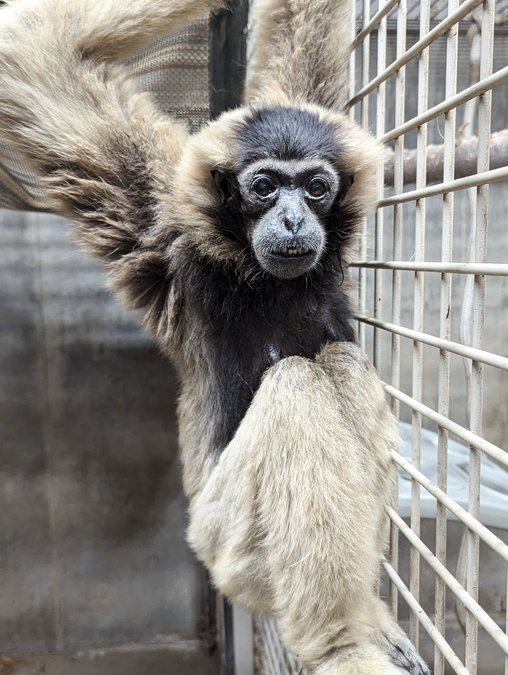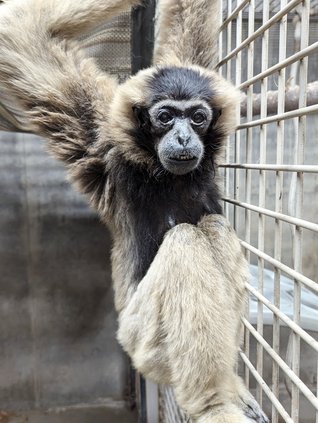The new pileated gibbon at the Great Bend Brit Spaugh Zoo remained out of sight of prying eyes, but her vocalizations could be heard loud and clear Wednesday morning from a closed building. The zoo’s lar gibbon, Manny, swung from a rope in his exhibit, definitely aware that someone new had arrived.
Great Bend City Administrator Logan Burns told the City Council on Monday that the new animal had arrived and that zookeepers hope she can become a companion to Manny.
Zoo Supervisor and Curator Ashley Burdick said the staff are in the process of introducing the gibbons to each other. By the end of the day Wednesday, they were sharing the outdoor exhibit area where Manny has lived alone since last December.
“Our gibbons are part of the Species Survival Plan,” Burdick said. “These are well-planned out entities that look at genetics and how best to pair animals for successful breeding and maintaining genetic diversity. These preserve the genetics to maintain healthy populations of animals whose numbers are dwindling in the wild due to habitat loss, poaching, the pet trade and deforestation. Because we are a small facility, we often take in older animals or non-breeding individuals. Manny, our male gibbon, has been here since 2022 and is almost 15 years old. At his previous facility he had a brain infection that affects his mobility and cognitive abilities, so he isn’t compatible with a normal individual. We lost our previous female gibbon, Rerun, who was almost 34, last year to age-related issues in various organ systems. We have been working with the SSP to bring in a suitable individual for Manny.
“Maggie is a pileated gibbon, which is a similar species to Manny the lar gibbon. There is not currently a program for pileated gibbons and there are less than five zoos that have this species in the U.S. Her exact history is not known, but historic records indicate she may have been a surrendered pet in Malaysia before moving to the Gibbon Conservation Center in the U.S. She is believed to be at least 40 years old. While gibbons can live to be 50, most individuals live 30-40 years,” Burdick continued.
“After learning that she had spent the last 20 years living without a companion, we worked with the SSP and felt we could be a good home for her remaining years where she could have a slower-paced companion. When you see her in the zoo, you may notice she has some hand deformities. She has had those since she was imported into the U.S. in the ’80s. Despite her hands and her age, she is very agile and gets around all areas of the exhibit with ease.
“We started the introductions after she was cleared from quarantine and so far they seem to be co-existing peacefully. They haven’t been observed socially grooming each other yet, but they have been heard calling their territory in the mornings. Maggie is smaller and a darker tan color with a black head and Manny is larger, lighter in color and fluffier. We hope the public enjoys Maggie as much as our keepers already do. She is a very sweet and sassy individual!”
The American Species Survival Plan or SSP program was developed in 1981 by the Association of Zoos and Aquariums to help ensure the survival of selected species in zoos and aquariums, most of which are threatened or endangered in the wild. Both lar gibbons and pileated gibbons are considered endangered.
The Hertfordshire Zoo website tells us there are 20 species of gibbon, all native to South and Southeast Asia. The lar gibbon or white-handed gibbon and the pileated gibbon or capped gibbon are both in the genus Hylobates.







